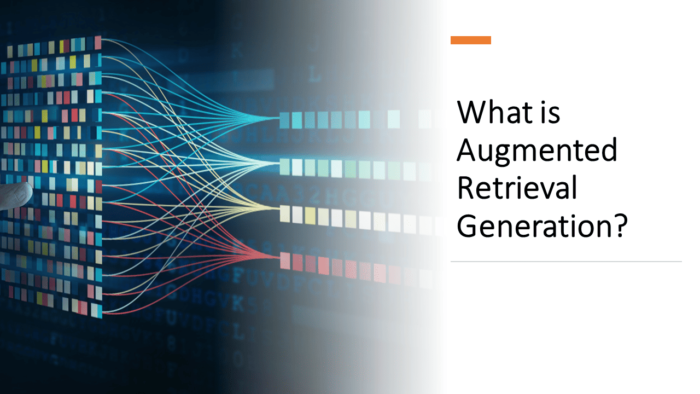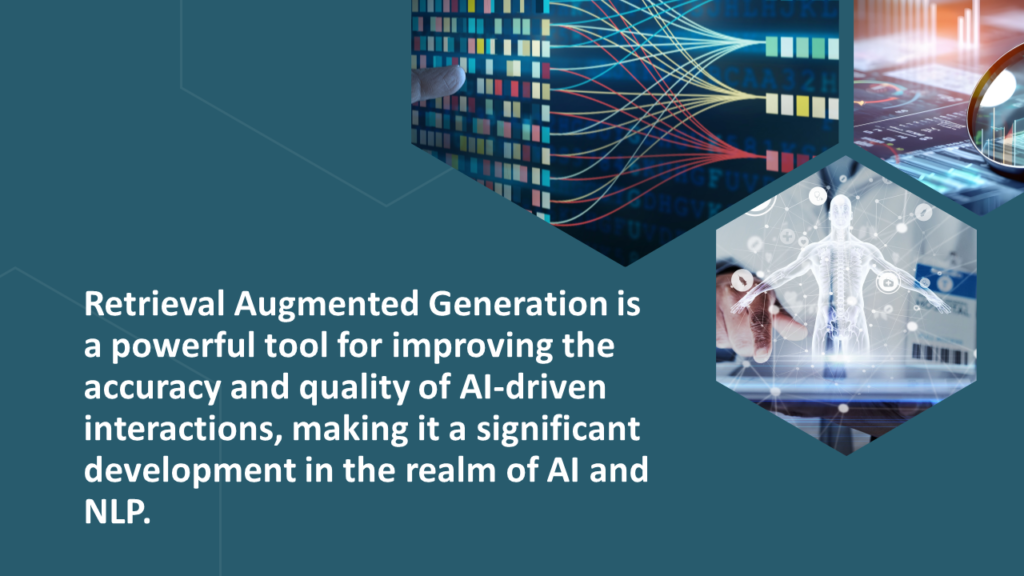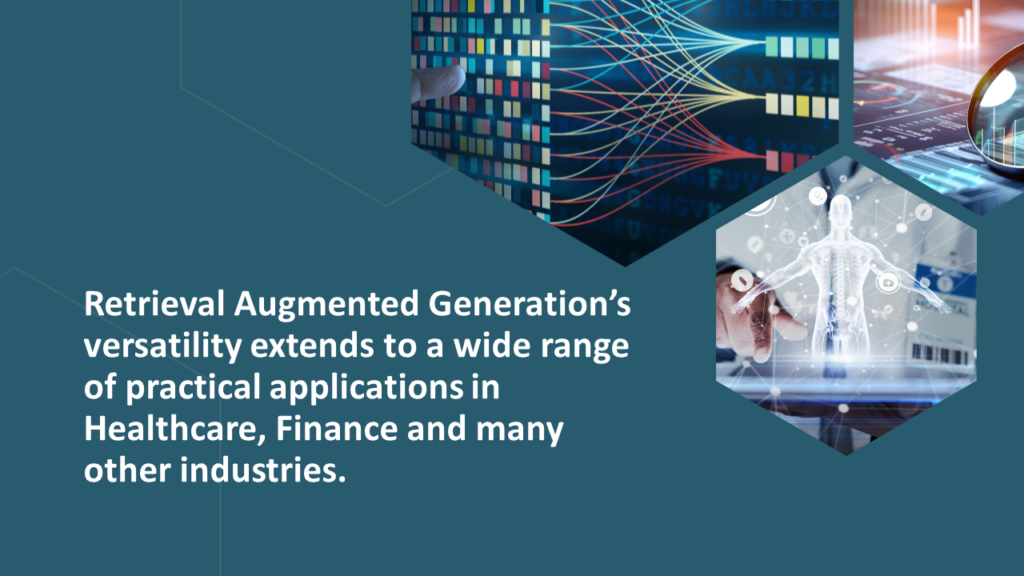What is Retrieval Augmented Generation?
One fascinating frontier in the ever-evolving landscape of artificial intelligence that has garnered significant attention is Retrieval Augmented Generation (RAG). This innovative approach represents a powerful synergy between two essential AI techniques: retrieval and generation. Imagine a system that not only comprehends your questions and retrieves relevant information but also has the ability to generate coherent and contextually appropriate responses. Retrieval Augmented Generation is not just a breakthrough; it’s a game-changer that promises to reshape how we interact with machines and harness the potential of AI for a multitude of applications. In this blog, we’ll delve deep into this transformative technology, exploring its key concepts, real-world applications, and its impact on software development.
What Is RAG?
Retrieval Augmented Generation (RAG) is an advanced technique in the field of artificial intelligence (AI) and natural language processing (NLP). It combines two crucial aspects of AI: retrieval and generation, to enhance the capabilities of language models and create more contextually relevant and informative responses.
Here’s a breakdown of Retrieval Augmented Generation:
Retrieval: This component involves retrieving information from a large database or corpus of text. It can be thought of as an AI system’s ability to access a vast amount of knowledge to find relevant information. Retrieval methods include searching through text, documents, or other data sources to extract valuable insights.
Generation: The generation part refers to the AI’s ability to create meaningful and coherent responses. This is often associated with language generation models like GPT (Generative Pre-trained Transformer), which can generate human-like text based on input or context.
In Retrieval Augmented Generation, these two aspects are combined to create AI systems that are not only knowledgeable but also capable of generating contextually relevant and accurate responses. Here’s how it typically works:
- A query or question is provided to the AI system.
- The system first retrieves relevant information from its knowledge base or external sources.
- It then uses this retrieved information to generate a response that addresses the query in a contextually meaningful way.
This approach is particularly useful in applications like question-answering systems, chatbots, information retrieval, and content summarization. It allows AI systems to provide more precise and context-aware answers by combining the advantages of retrieval and generation techniques.
Retrieval Augmented Generation is a powerful tool for improving the accuracy and quality of AI-driven interactions, making it a significant development in the realm of AI and NLP.
The Importance of Retrieval Augmented Generation
RAG is important because it combines the strengths of information retrieval and text generation, allowing AI systems to provide more contextually relevant and accurate responses to user queries. This not only enhances user experiences in applications like chatbots and question-answering systems but also has significant implications for improving information retrieval and content summarization, making it a crucial advancement in the field of artificial intelligence and natural language processing.
Let’s delve into why this technology is considered a game-changer and why it has become increasingly important.
Improved Content Quality: RAG significantly elevates the quality of generated content. By blending generative capabilities with retrieval-based information, it ensures that the content produced is not only grammatically correct but also contextually accurate and informative.
Enhanced Information Retrieval: In scenarios where accessing and providing accurate information is crucial, such as healthcare, legal, or educational sectors, RAG shines. It can swiftly retrieve and incorporate up-to-date data, ensuring that the content remains relevant and reliable.
Personalized Recommendations: One of RAG’s remarkable abilities is to generate personalized recommendations. By analyzing user data and seamlessly integrating generative AI, it can offer tailored suggestions, transforming industries like е-commerce and entertainment by enhancing user engagement and satisfaction.
Natural Language Understanding: RAG enhances the ability of AI systems to understand and respond to natural language queries, making it more user-friendly and accessible. This is particularly beneficial for customer support chatbots and virtual assistants.
Real-Time Data Integration: In fast-paced industries like finance and news reporting, RAG’s real-time data integration capabilities are indispensable. It can provide immediate updates and insights by retrieving and incorporating the latest information into generated content.
Retrieval Augmented Generation Use Cases
Retrieval Augmented Generation’s versatility extends to a wide range of practical applications. Here are some of the most prominent use cases:
Healthcare Diagnosis and Treatment Recommendations: In healthcare, RAG can assist medical professionals by generating detailed reports and treatment recommendations based on patient data and the latest medical research. It helps healthcare providers with making informed decisions quickly.
Legal Document Generation: In the legal field, RAG can automate the generation of legal documents, contracts, and briefs streamlining the legal document creation process, reducing errors, and saving time for legal professionals. It ensures that the documents are not only legally sound but also up to date with current regulations.
News Article Summarization: For news agencies, RAG can automatically summarize lengthy news articles, making it easier for readers to grasp the main points and stay informed in a time-efficient manner.
Language Translation and Localization: RAG can enhance language translation services by generating contextually accurate translations, helping businesses communicate effectively with global audiences while preserving cultural nuances.
Financial Reporting and Analysis: In finance, RAG can generate real-time financial reports and analysis by retrieving and incorporating the latest market data, enabling investors and analysts to make informed decisions and stay ahead in a dynamic market environment. This empowers them to respond quickly to changing market conditions, identify investment opportunities, and manage risks effectively.
How Does RAG relate to Software Development?
Retrieval Augmented Generation can have several applications and implications in the field of software development with benefits that can revolutionize various aspects of the software development lifecycle.
Code Generation: RAG can automatically generate code snippets or entire software programs. This is particularly valuable for repetitive tasks, boilerplate code, or code patterns that follow established conventions such as user interface code for common components like buttons, forms, or navigation menus. By leveraging generative AI within RAG, developers can accelerate the software development process, reduce manual coding efforts, and minimize errors.
Automated Testing: Generative models within RAG can create test cases, scenarios, and even simulate user interactions with software applications. This automated testing process helps ensure software quality, thoroughly evaluate software performance and functionality, and identify potential issues early in development. It also reduces the need for manual testing, resulting in more robust and reliable software.
Natural Language Interfaces: RAG can assist in developing natural language interfaces (NLI) for software applications. This NLIs enable users to interact with software systems using conversational language, making software more user-friendly and accessible. Natural language interfaces are increasingly important in modern software, particularly in virtual assistant and chatbot applications.
Data Augmentation: Generative AI within RAG can create synthetic data for training machine learning models used in software applications. This is particularly valuable when real-world data is limited, sensitive, or difficult to obtain. Synthetic data generation enhances model training and improves the robustness of AI-driven software.
Bug Detection and Resolution: RAG can assist in identifying and even suggesting resolutions for code-related issues and bugs. By analyzing existing codebases and leveraging knowledge from vast datasets, RAG can help developers identify potential problems and propose solutions. RAG can automate code reviews, flagging code segments that may violate coding standards or contain potential bugs, thereby improving code quality and maintainability.
User Documentation: RAG can automatically generate user documentation, help files, and tooltips for software applications. This not only saves time for technical writers but also ensures that user documentation remains up-to-date as the software evolves.
Leveraging i3solutions For Success
Leveraging a technology partner like i3solutions for RAG implementation can provide you with the expertise, efficiency, and support needed to successfully integrate this advanced technology into your business processes. We can help you unlock the full potential of RAG while mitigating risks and ensuring a seamless, customized solution for your organization.
Here’s how i3solutions can contribute to your overall success:
Custom RAG Models: i3solutions specializes in developing bespoke RAG models tailored to your specific needs. These custom models are designed to meet your unique requirements, ensuring optimal performance and results.
Data Integration: Integrating RAG solutions with your existing data sources and systems can be complex. i3solutions excels in this area, streamlining the information retrieval process and ensuring seamless data integration.
Continuous Improvement: i3solutions offers ongoing support and refinement for your RAG applications. We work to maximize the efficiency and effectiveness of your AI systems, ensuring that they evolve with the ever-changing landscape of technology.
Retrieval Augmented Generation is a transformative approach with the potential to redefine how we interact with technology across various industries. Its applications are not only wide-ranging but also have the capacity to enhance the quality of content, streamline processes, and improve user experiences.
Whether you’re considering implementing RAG in your organization or exploring its possibilities, partnering with experts like i3solutions can be instrumental in achieving success in this exciting field of AI and NLP. Embrace the future, stay ahead of the curve, and unlock the limitless potential that RAG has to offer.
For more information on how to leverage the power of generative or retrieval-based AI systems, reach out to i3solutions today!
Leave a Comment




